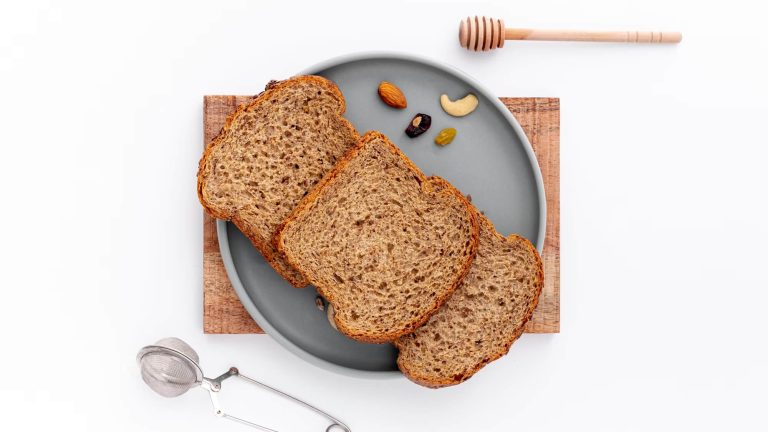In the world of bread, where choices range from fluffy white loaves to hearty whole-grain options, honey wheat bread stands out as a golden, slightly sweet contender. With its warm hue and tempting aroma, it beckons from bakery shelves and sandwich menus, leaving many of us wondering: Is honey wheat bread good for you?
Bread enthusiasts and health-conscious eaters alike have pondered the merits of this delicious creation. Is it a nutritious choice, or should we stick to more traditional whole-grain varieties?
So, fasten your seatbelts and prepare to explore the world of honey wheat bread as we answer the question: Is honey wheat bread a wholesome addition to your diet?
What is Honey Wheat Bread?
Honey wheat bread is a delightful and nutritious type of bread that combines the rich flavors of honey and whole wheat. It is a staple in many households and bakeries due to its slightly sweet taste and numerous health benefits.
Let’s take a closer look at what makes honey wheat bread unique:
1. Ingredients and Production Process
Honey wheat bread is primarily made from a combination of whole wheat flour, water, yeast, and honey. The honey adds a natural sweetness to the bread, which distinguishes it from traditional whole wheat bread.
Here’s a brief overview of the production process:
- Mixing: Whole wheat flour, yeast, water, honey, and sometimes a bit of salt are combined to create the dough.
- Kneading: The dough is kneaded thoroughly to develop its gluten structure, which gives the bread its characteristic texture.
- Rising: The dough is left to rise, allowing the yeast to ferment and create bubbles, which make the bread light and airy.
- Baking: After rising, the dough is baked in an oven, resulting in a golden-brown crust and a soft interior.
2. Comparison with White Bread
It differs significantly from white bread, not only in terms of ingredients but also in nutritional value. White bread is typically made from refined flour, which means it lacks the bran and germ parts of the wheat grain, containing fewer nutrients and dietary fiber.
In contrast, honey wheat bread is made from whole wheat flour, which includes these nutritious components.
3. Variations of Honey Wheat Bread
It comes in various forms, including:
- Traditional Loaves: Sliced and perfect for sandwiches or toast.
- Rolls and Buns: Ideal for making burgers and sandwiches.
- Cinnamon Raisin: A sweet twist on honey wheat bread with added cinnamon and raisins.
- Seeded Varieties: Some honey wheat bread recipes incorporate seeds like sesame, flax, or sunflower for added texture and nutrition.
These variations allow you to enjoy honey wheat bread in different ways to suit your taste and dietary preferences.
Nutritional Profile of Honey Wheat Bread
The nutritional profile of honey wheat bread makes it a popular choice for those seeking a balance between flavor and health benefits. Here’s a breakdown of its key nutritional components:
1. Calories and Serving Size
A typical serving of honey wheat bread is one slice, and it contains approximately 70-80 calories. Serving sizes may vary slightly depending on the brand and recipe.
2. Macronutrient Content
- Carbohydrates: Honey wheat bread is primarily a source of carbohydrates, providing about 12-15 grams per slice.
- Protein: It contains around 2-3 grams of protein per slice.
- Fats: The fat content is relatively low, with about 1 gram or less per slice.
3. Dietary Fiber Content
It is a good source of dietary fiber, thanks to its whole wheat flour content. It typically contains 2-3 grams of fiber per slice. Dietary fiber is essential for digestive health and can help with satiety and managing blood sugar levels.
4. Vitamins and Minerals
It provides essential vitamins and minerals, including:
- B Vitamins: Thiamin (B1), riboflavin (B2), niacin (B3), and folate (B9).
- Minerals: Iron, magnesium, phosphorus, and zinc.
These nutrients play various roles in maintaining overall health, including energy metabolism and red blood cell formation.
5. Antioxidants and Phytonutrients
The whole wheat content in honey wheat bread contains antioxidants and phytonutrients that can help protect cells from damage caused by free radicals.
6. Honey’s Nutritional Benefits
Honey, a key ingredient in honey wheat bread, provides natural sweetness and has potential health benefits, including antibacterial properties and the presence of antioxidants.
7. Low in Saturated Fat and Cholesterol
It is typically low in saturated fat and cholesterol, making it a heart-healthy choice.
It’s important to note that the specific nutritional content of honey wheat bread may vary among brands and recipes. Some commercially-produced versions may also contain added sugar or high-fructose corn syrup, so it’s a good practice to check the ingredient label when choosing your bread.
For maximum health benefits, opt for honey wheat bread made with whole wheat flour, minimal added sugars, and wholesome ingredients.
Health Benefits of Honey Wheat Bread
Honey wheat bread offers a range of health benefits, making it a nutritious choice for those looking to enhance their diet. Here are some of the key health benefits associated with consuming honey wheat bread:
1. Rich in Whole Grains
Honey wheat bread is typically made from whole wheat flour, which means it contains the entire wheat kernel, including the bran and germ. This makes it a significant source of whole grains.
Whole grains are known for their numerous health benefits, such as improved digestive health, better weight management, and reduced risk of chronic diseases like heart disease and type 2 diabetes.
2. Dietary Fiber
It is a good source of dietary fiber, which supports healthy digestion. Fiber can help regulate bowel movements, prevent constipation, and promote a feeling of fullness, which may aid in weight management.
3. Nutrient-Rich
This type of bread contains essential nutrients like vitamins (B vitamins, particularly) and minerals (such as iron, magnesium, and zinc). These nutrients play crucial roles in various bodily functions, including energy metabolism, red blood cell production, and immune system support.
4. Potential Heart Health Benefits
Honey wheat bread’s whole grains are associated with heart health benefits. They can help reduce the risk of heart disease by lowering cholesterol levels and improving blood pressure.The fiber in honey wheat bread also contributes to heart health by reducing LDL (“bad”) cholesterol levels.
5. Natural Sweetness of Honey
Honey is used in honey wheat bread not only for its flavor but also for its potential health benefits. It contains antioxidants that can help combat oxidative stress and inflammation in the body.
6. Weight Management
The fiber content in honey wheat bread can help you feel fuller for longer, potentially reducing overall calorie intake.When incorporated into a balanced diet, honey wheat bread can be a satisfying and nutritious option for those looking to manage their weight.
7. Sustained Energy
The carbohydrates in honey wheat bread provide a steady source of energy, making it a suitable choice for active individuals or as a pre- or post-workout snack.
8. Versatility in Healthy Eating
Honey wheat bread can be used to make a variety of nutrient-rich sandwiches and snacks. By choosing wholesome toppings like lean proteins, vegetables, and healthy spreads, you can create balanced and satisfying meals.
9. Promotes Overall Dietary Diversity
Including honey wheat bread in your diet diversifies your carbohydrate sources and adds a touch of sweetness without the need for excessive added sugars.
It’s worth noting that while honey wheat bread offers several health benefits, the overall quality of your diet matters. Pairing honey wheat bread with a variety of nutritious foods and maintaining a balanced diet is essential for maximizing its advantages and promoting overall well-being.
Potential Drawbacks and Considerations
While honey wheat bread has many health benefits, it’s important to be aware of potential drawbacks and considerations to make informed dietary choices.
Here are some of the potential drawbacks and things to keep in mind when consuming honey wheat bread:
1. Added Sugars
Some commercially-produced honey wheat bread varieties may contain added sugars, which can increase the calorie content and reduce the overall nutritional value. Check the ingredient list to ensure that the bread you choose doesn’t contain excessive amounts of added sugars.
2. Gluten Content
It contains gluten, a protein found in wheat and related grains. This may not be suitable for individuals with celiac disease or non-celiac gluten sensitivity. Gluten-free alternatives should be considered for those with gluten-related disorders.
3. Sodium Levels
Some brands of honey wheat bread may have higher sodium content, which can contribute to high blood pressure and other health concerns if consumed in excess. Look for low-sodium options, especially if you are watching your salt intake.
4. Allergenic Concerns
It contains common allergens such as wheat and, in some cases, tree nuts or seeds.
Individuals with food allergies or sensitivities should carefully read ingredient labels to avoid potential allergens.
5. Portion Control
While honey wheat bread can be a nutritious choice, it’s important to practice portion control, as excessive consumption can lead to excess calorie intake. Pay attention to serving sizes to avoid overindulging.
6. Dietary Goals and Preferences
Dietary preferences, such as vegan or vegetarian diets, may influence the types of honey wheat bread you choose, as some recipes contain animal-derived ingredients like honey. Select brands and recipes that align with your dietary choices and ethical considerations.
7. Individual Nutritional Needs
The suitability of bread depends on an individual’s specific nutritional needs and health goals.
Consult with a healthcare professional or registered dietitian to determine how honey wheat bread fits into your unique dietary plan.
8. Variability Among Brands
The nutritional content of bread can vary among brands and recipes. Read nutrition labels carefully and choose brands that prioritize whole grains and minimal additives.
It can be a nutritious addition to a well-balanced diet when chosen wisely and consumed in moderation. Being mindful of ingredient lists, serving sizes, and individual dietary needs will help you make the most of its health benefits while avoiding potential drawbacks.
Incorporating Honey Wheat Bread into a Healthy Diet
Incorporating honey wheat bread into a healthy diet is a delicious and nutritious way to enjoy its benefits. Here are some tips and ideas for making the most of honey wheat bread while maintaining a balanced and health-conscious eating plan:
1. Choose Whole Grain Varieties
Opt for honey wheat bread made with whole wheat flour to maximize its nutritional content and fiber. Check the ingredient list for “whole wheat” as the first ingredient.
2. Portion Control
Pay attention to portion sizes. One or two slices of honey wheat bread can be part of a healthy meal or snack, depending on your nutritional needs and goals.
3. Balanced Sandwiches
Use honey wheat bread to make wholesome sandwiches. Load them with lean proteins (like grilled chicken, turkey, or tofu), plenty of fresh vegetables, and healthy spreads (such as hummus or avocado) for a well-rounded meal.
4. Nut Butter Delight
Spread natural almond or peanut butter on honey wheat bread for a protein-packed and satisfying snack or breakfast option. Top with sliced bananas or berries for added flavor and nutrition.
5. Toasted for Crunch
Toasted bread can add a delightful crunch to your meals. Enjoy it as a base for avocado toast, a vehicle for poached eggs, or with a light drizzle of honey for a sweet treat.
6. Nutrient-Rich French Toast
Turn honey bread into a nutritious French toast by dipping slices in a mixture of egg whites, a touch of milk, and a pinch of cinnamon. Cook until golden brown and serve with fresh fruit and a sprinkle of nuts.
7. Veggie-Packed Panini
Create a veggie-packed panini with honey wheat bread. Layer grilled vegetables, cheese, and a touch of olive oil or balsamic vinegar for a flavorful and satisfying sandwich.
8. Soup and Salad Companion
Serve honey wheat bread alongside a hearty soup or a leafy green salad. It’s a great way to add some whole grains to your meal for extra fiber and satiety.
9. DIY Croutons
Transform stale honey wheat bread into homemade croutons. Cube the bread, toss it with olive oil and your favorite herbs, and bake until crispy. Use them to add texture and flavor to salads or soups.
10. Snack Smart
Cut honey wheat bread into bite-sized pieces, toast them, and use them as a healthier alternative to chips for dipping into hummus, salsa, or guacamole.
11. Grilled Cheese Upgrade
Make a nutritious grilled cheese sandwich with honey wheat bread. Use whole-milk or low-fat cheese and add tomato slices or spinach for added vitamins and minerals.
Remember that a healthy diet is not just about individual foods but also about overall dietary patterns. Incorporate bread as part of a balanced diet that includes a variety of foods from different food groups to ensure you get a wide range of nutrients.
It’s always a good idea to consult with a registered dietitian or healthcare professional for personalized dietary recommendations.
Buying and Baking Tips
When it comes to honey wheat bread, whether you’re buying it from the store or baking it at home, there are some tips and considerations to keep in mind to ensure you get the best quality and flavor.
Here are some buying and baking tips:
Buying Tips
- Read Ingredient Labels: Always check the ingredient list when buying honey wheat bread. Look for bread that lists whole wheat flour as the first ingredient and contains minimal additives and preservatives.
- Look for Minimal Added Sugars: Some commercial honey wheat bread may have added sugars. Choose options with little to no added sugars or those sweetened with honey, molasses, or other natural sweeteners.
- Check Sodium Content: Be mindful of the sodium content, especially if you are watching your salt intake. Look for lower-sodium varieties if necessary.
- Freshness Matters: Choose bread from reputable bakeries or brands known for their quality. Freshly baked honey wheat bread typically has better flavor and texture.
- Consider Organic Options: Organic bread is made from wheat grown without synthetic pesticides or fertilizers. If you prefer organic products, look for certified organic options.
- Store Properly: Store your honey bread in an airtight container or plastic bag to maintain freshness. Freeze extra slices if you don’t plan to use them right away.
Baking Tips (for Homemade Honey Wheat Bread):
- Use Whole Wheat Flour: When baking honey wheat bread at home, opt for whole wheat flour for a richer flavor and greater nutritional value.
- Balance Honey and Yeast: Adjust the amount of honey in your recipe to suit your desired level of sweetness. Be mindful not to overdo it, as too much honey can affect the bread’s texture and rise.
- Kneading and Rising: Properly knead the dough to develop gluten and allow it to rise sufficiently for a light and airy texture. Follow the recipe instructions carefully.
- Add Texture: Consider adding seeds (like sesame, flax, or sunflower seeds) to your dough for added texture, flavor, and nutritional value.
- Preheat Your Oven: Make sure your oven is fully preheated to the specified temperature before placing the bread inside. This ensures even baking.
- Check Doneness: Use a thermometer to check the internal temperature of the bread. It should reach about 190-200°F (88-93°C) when fully baked.
- Cool Properly: After baking, allow the bread to cool on a wire rack. Cooling prevents the crust from becoming soggy.
- Experiment: Don’t be afraid to experiment with different recipes and variations of honey wheat bread to find your preferred taste and texture.
- Practice Patience: Baking bread can be a process that requires patience and practice. Don’t get discouraged if your first attempt doesn’t turn out perfect.
- Enjoy Fresh: Homemade honey wheat bread is best enjoyed fresh. Consume it within a couple of days or freeze extra loaves for later use.
Is Honey Wheat Bread Ok for Diabetics?
Honey wheat bread can be consumed by individuals with diabetes, but it’s important for those with diabetes to consider some key factors when incorporating it into their diet. Here are some considerations for individuals with diabetes regarding honey wheat bread:
1. Carbohydrate Content
Like all bread, honey wheat bread contains carbohydrates, which can raise blood sugar levels. It’s crucial to monitor carbohydrate intake and plan meals accordingly if you have diabetes. Pay attention to portion sizes, as the number of carbohydrates you consume directly affects your blood sugar. One or two slices of honey wheat bread can fit into a balanced meal plan.
2. Fiber Content
Honey wheat bread is often made from whole wheat flour, which is a good source of dietary fiber. Fiber can help stabilize blood sugar levels by slowing the absorption of carbohydrates. Choose honey wheat bread with higher fiber content to help manage blood sugar.
3. Glycemic Index (GI)
The GI measures how quickly carbohydrates in a food raise blood sugar levels. Whole wheat bread, including bread, generally has a lower GI compared to white bread. Lower-GI foods are better for managing blood sugar, as they have a gentler impact on glucose levels.
4. Added Sugars
Some commercially-produced bread may contain added sugars. It’s essential to check the ingredient list and choose varieties with minimal added sugars or opt for recipes with little or no added sweeteners.
5. Portion Control
Keep portion sizes in check to avoid consuming excessive carbohydrates. Pair honey wheat bread with lean proteins, healthy fats, and plenty of non-starchy vegetables to create a balanced meal.
6. Monitor Blood Sugar
Monitor your blood sugar levels regularly to understand how honey wheat bread, and other foods, affect your individual response. This can help you make personalized dietary choices.
7. Individual Response
People with diabetes can have different responses to carbohydrates. What works for one person may not work for another. It’s important to work with a registered dietitian or healthcare provider to create a meal plan tailored to your specific needs and goals.
8. Timing Matters
Consider when you consume honey wheat bread. Pair it with protein and healthy fats to help mitigate blood sugar spikes, and try to include it in meals rather than as a standalone snack.
Conclusion
Honey wheat bread is a versatile and nutritious option that can be a valuable addition to a balanced diet for many individuals. Its rich flavor, whole grain goodness, and potential health benefits make it a popular choice among those seeking both taste and nutrition. However, like any food, it comes with considerations and potential drawbacks that require attention, especially for individuals with specific dietary needs or health concerns.
It’s nutritional profile, featuring whole grains, dietary fiber, vitamins, minerals, and the natural sweetness of honey, offers numerous advantages. It can support heart health, digestive wellness, and sustained energy throughout the day. Additionally, it serves as a canvas for creating delicious and nutrient-rich meals and snacks.
Nevertheless, it’s essential to be mindful of added sugars, gluten content, sodium levels, and portion control when enjoying honey wheat bread.
For those who enjoy baking, homemade honey wheat bread offers the opportunity to tailor the recipe to meet specific dietary preferences and nutritional goals. Experimenting with ingredients and techniques can result in a personalized and wholesome loaf.
In the journey towards better health and well-being, honey wheat bread can play a valuable role, contributing not only to your palate’s delight but also to your overall nutritional success. Remember that a balanced and diverse diet is key, and making informed choices allows you to savor the goodness of honey wheat bread while reaping its many rewards. I hope you got the answer that is honey wheat bread good for you or not?






porn
child porn